|
|
Post by instaforexgertrude on Dec 12, 2017 0:11:33 GMT -5
Pound fled from politicsA busy economic calendar and the departure of political risks into obscurity allows us to hope for the return of investors in actively trading the pound. Semiannual negotiations between London and Brussels, judging by the statements of the latter, were completed successfully, which makes it necessary to shift attention to macroeconomic data. In general, there is plenty of data at the beginning of the second week of the month for the UK. Inflation, the labor market, retail sales and the meeting of the Bank of England will satisfy even the highest demands of trade analysts on the news. The fall of sterling in response to positive news from the negotiation table on Brexit has become a classic example of the implementation of the principle of "buy on the rumor, sell on the facts." Traders sold the GBP/USD quotes on the factor of harmonizing the conditions of the divorce between Britain and the EU, and the message that the round-the-clock work was over and the issue of the Irish border was resolved. This launched a wave of selling against the backdrop of profit taking. Moreover, popular media referring to competent sources reported that the trade deal before the spring of 2018 will not be achieved. However, the bridgehead is laid, and the bulls on sterling, including Nomura and ING, believe that the reduction of political risks of the UK will push the GBP/USD pair in the direction of 1.4 in 2018 and 1.36 in the near future. On the contrary, "bears" criticize the agreement that was reached, blaming it for lack of details, and referred to the futures market, where the value of options to sell sterling is higher than the purchase. Derivatives are used for risk insurance, and the current dynamics of an indicator such as the risk of reversal (the ratio of premiums on call and put), indicates that investors still fear the sterling's collapse. Dynamics of the ratio of premiums on options  Source: Bloomberg. On the other hand, speculators in the futures market held a net long position on the pound for 6 of the last 10 weeks, although before that they acted as net sellers for 98 five-day consecutive days. Lately, there have been too many news with political coloring, and it's time for the sterling to turn its focus on the economy. In general, the outlook for upcoming releases is moderately positive. Bloomberg experts do not expect inflation to exceed the critical level of 3%, while the acceleration of average wages from 2.2% to 2.5% y/y. In addition to that, the exit from the negative territory of retail sales inspires optimism for bulls in the GBP/USD pair. Moreover, it is beneficial for the Bank of England to maintain a strong pound with the help of "hawkish" rhetoric, and the dollar cannot take advantage of strong data on the US. It is possible that the growth of the fiscal deficit as a result of the implementation of the tax reform, the reluctance of Donald Trump to see the US currency strong and the recovery of the economies of the competing countries will force the USD index to restore the downward trend in 2018. Technically, the GBP/USD pair is preparing to retest the upper bound of the previous consolidation range at 1.304-1.332. Assuming that it, like the previous one, ends with the defeat of the "bears", the likelihood of a restoration of the uptrend in the sterling will then increase. GBP/USD, daily chart 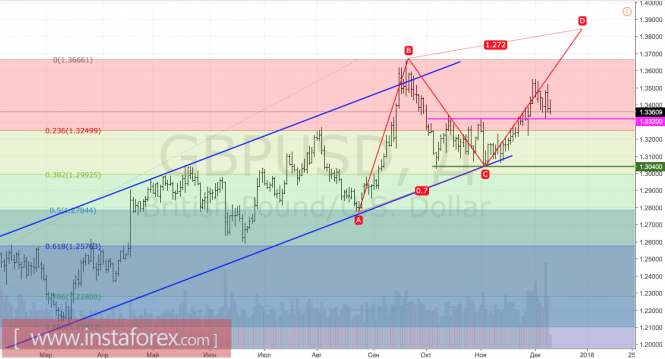 *The market analysis posted here is meant to increase your awareness, but not to give instructions to make a trade. Analysis are provided byInstaForex.
|
|
|
|
Post by instaforexgertrude on Dec 13, 2017 23:40:48 GMT -5
British income levels dropThe British pound did not pay attention to data on pay cuts in the UK from August to October of this year, and this could negatively affect retail as well as GDP growth. Let me remind you that the fall in real incomes of citizens started last year, when the UK decided on a vote to leave the EU. According to the report, from August to October 2017 compared with the same period of last year, real wages fell by 0.4%. The unemployment rate in the UK for the same period remained unchanged at 4.3%. Economists expected a drop in the unemployment rate by 0.1 percentage points. 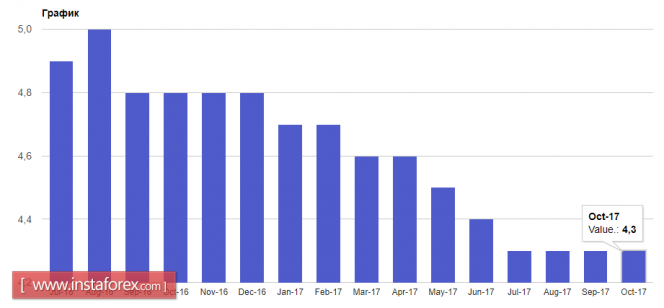 As for the pound's immediate prospects, much of it will depend on the decision of the Bank of England on Thursday. Although it is projected that the regulator will leave interest rates unchanged. It will be important to know how the members of the Committee on Monetary Policy will vote for constant interest rates and quantitative easing. If the Bank of England mentions good progress in Brexit talks during the comments, it will also benefit the British pound, which can significantly strengthen its positions against the US dollar. As for the technical picture of the GBP/USD pair, further growth is directly dependent on the breakthrough of a large resistance located in the area of 1.3375. Levels that are above 1.3425 and 1.3480 are considered good. In the event of a channel breakout in the lower limit of 1.3300, one can expect an increase in pressure on the pound with a decline towards 1.3225 and 1.3150. Inflation data in Germany slightly affected the quotations of the European currency during the first half of Wednesday, as it coincided with the forecasts of economists. According to a report of the statistics agency, the final consumer price index of Germany in November this year increased by 0.3% compared with October. Economists also expected the index to increase by 0.3%. As for the same period for 2016, prices have increased by 1.8% overall. As for the important events in the afternoon, attention should be focused on the Fed hiking the interest rate, as well as a signal about what will be the acceleration of the normalization of monetary policy next year. As for the technical picture of the EUR/USD pair, the bulls managed to win back Tuesday's euro decline in the afternoon and returned to the intermediate level of support 1.1740 without much difficulty. While the trade is going above this range, we can count on a further upward trend for the euro with an update of 1.1775 and an exit to weekly highs around 1.1810. *The market analysis posted here is meant to increase your awareness, but not to give instructions to make a trade. Analysis are provided byInstaForex.
|
|
|
|
Post by instaforexgertrude on Dec 14, 2017 23:44:42 GMT -5
ECB leaves rates and economic forecast unchangedThe euro met with minimal hesitation at the key decision of the European Central Bank this week. According to the data, the European Central Bank left the refinancing rate unchanged at 0.0%, while stating that interest rates will remain at current levels for a long time after the end of the asset purchase program. Many experts expected that the ECB would make hints on the gradual tightening of monetary policy by the time of the completion of the curtailment of the asset repurchase program, which is scheduled for the end of next year. However, as we can see, this is not included in the plans of the ECB and there are a number of objective reasons for this. At the very least, this is the missing price pressure, which is kept quite low for quite a long time even after good economic growth in the second and third quarters of this year. The labor market in the euro area also shows growth but the rate of increase in wages is far from ideal. 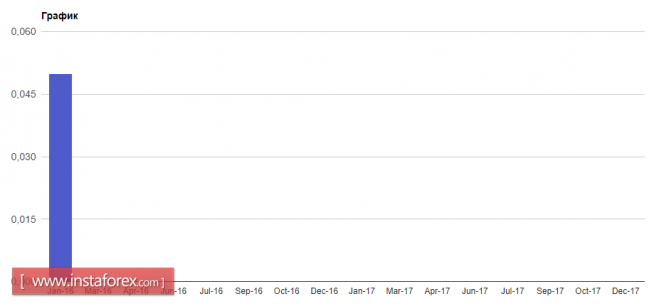 The ECB also revealed that they will reinvest funds received from the redemption of bonds for a long period after the completion of the curtailment of the asset purchase program. In the morning, preliminary data on the PMI supply managers' index for France's manufacturing sector for December came out. It rose significantly to 59.3 points versus 57.7 points in November. Economists had expected PMI for the manufacturing sector to be at 57.1 points. A similar preliminary index of supply managers PMI for Germany's manufacturing sector for the month of December this year rose to 63.3 points against 62.5 points in November. Economists expected the index to fall to 62.1 points. As for the euro area as a whole, the preliminary composite index of supply managers for the euro zone's PMI in December this year increased to 58.0 points with a forecast at 57.3 points, which is slightly lower than the November figure of 57.5 points. In the second half of the day, data on the US labor market came out. According to a report by the US Department of Labor, the number of Americans who applied for unemployment benefits last week declined. Thus, the number of initial applications for unemployment benefits for the week of December 3 to 9 decreased by 11,000 and amounted to 225,000. Economists predicted that the number of applications would be at 235,000. *The market analysis posted here is meant to increase your awareness, but not to give instructions to make a trade. Analysis are provided byInstaForex.
|
|
|
|
Post by instaforexgertrude on Dec 18, 2017 0:38:17 GMT -5
Technical analysis of EUR/USD for Dec 18, 2017 When the European market opens, some Economic Data will be released, such as German Buba Monthly Report, Final Core CPI y/y, Final CPI y/y, and Italian Trade Balance. The US will release the Economic Data, too, such as NAHB Housing Market Index, so, amid the reports, EUR/USD will move in a ... volatility during this day. TODAY'S TECHNICAL LEVEL: Breakout BUY Level: 1.1805. Strong Resistance:1.1798. Original Resistance: 1.1787. Inner Sell Area: 1.1776. Target Inner Area: 1.1748. Inner Buy Area: 1.1720. Original Support: 1.1709. Strong Support: 1.1698. Breakout SELL Level: 1.1691. *The market analysis posted here is meant to increase your awareness, but not to give instructions to make a trade. Analysis are provided byInstaForex.
|
|
|
|
Post by instaforexgertrude on Dec 18, 2017 23:52:49 GMT -5
Elliott wave analysis of EUR/JPY for December 19, 2017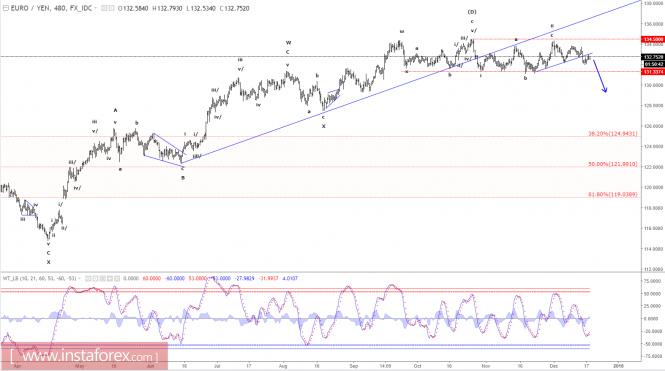 Wave summary: EUR/JPY is back testing the broken minor support-line, which now acts as resistance. This former support, now resistance, is expected to cap the upside for more downside pressure towards the pivot point at 131.14, which needs to be broken to confirm that wave (D) completed at 134.50 and wave (E) now is developing towards the ideal target seen at 123.43. Short-term a break below minor support at 132.10 confirms more downside pressure towards 131.14. R3: 133.89 R2: 133.76 R1: 133.00 Pivot: 132.10 S1: 131.70 S2: 131.14 S3: 130.56 Trading recommendation: We are short EUR from 133.40 with stop placed at 133.80. *The market analysis posted here is meant to increase your awareness, but not to give instructions to make a trade. Analysis are provided byInstaForex.
|
|
|
|
Post by instaforexgertrude on Dec 20, 2017 1:45:57 GMT -5
AUD/JPY reversing nicely below major resistance The price has started to form a really nice reversal pattern with bearish divergence being formed. We look to sell below major resistance at 86.67 (Multiple Fibonacci retracements, horizontal overlap resistance, bearish divergence) for a push down to at least 84.69 support (Fibonacci extension, horizontal swing low support). Stochastic (55,3,1) is seeing major resistance below 98% where we expect a corresponding drop from. We're also seeing bearish divergence vs price signaling that a reversal is impending. Sell below 86.67. Stop loss is at 87.34 Take profit is at 84.69. 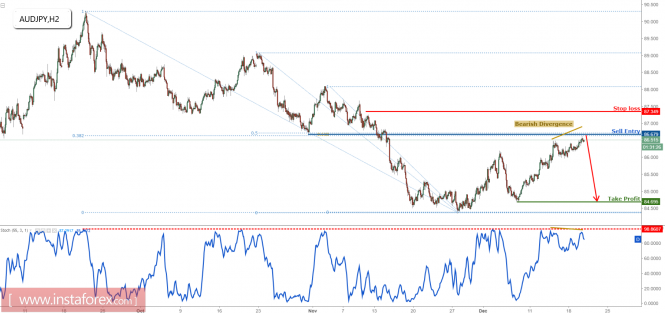 *The market analysis posted here is meant to increase your awareness, but not to give instructions to make a trade. Analysis are provided byInstaForex.
|
|
|
|
Post by instaforexgertrude on Dec 21, 2017 1:21:58 GMT -5
Elliott wave analysis of EUR/JPY for December 21, 2017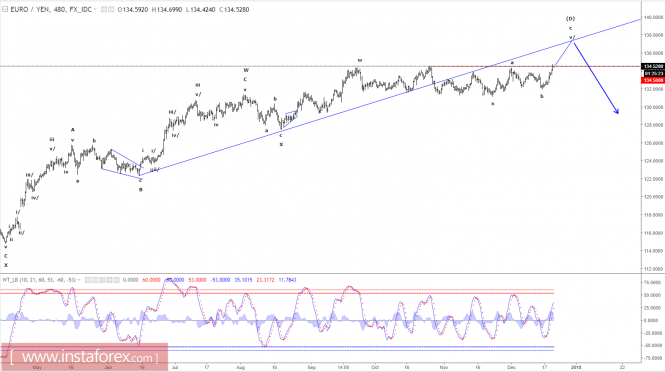 Wave summary: The break above resistance at 134.50 told us that wave (D) still is developing and more upside towards the "old" 137.37 target should be expected to complete wave (D) and set the stage for the final decline within the huge triangle consolidation, that has been developing since July 2008. Support is now seen at 134.40 and again at 133.84. The later should be able to protect the downside for more upside closer to 137.37. R3: 136.05 R2: 135.75 R1: 134.90 Pivot: 134.40 S1: 133.84 S2: 133.57 S3: 133.24 Trading recommendation: We will buy EUR at 134.10 and place our stop at 133.40. *The market analysis posted here is meant to increase your awareness, but not to give instructions to make a trade. Analysis are provided byInstaForex.
|
|
|
|
Post by instaforexgertrude on Dec 22, 2017 1:05:45 GMT -5
The US dollar returns to the gameData in the first half of the Thursday exerted pressure on the European currency, not allowing it to get beyond its weekly highs against the US dollar. According to the report of a statistics agency, the level of confidence in the manufacturing sector in France in December of this year declined. Thus, the index of sentiment of companies in the manufacturing sector was at 112 points against the November value of 113 points. Despite this, a high level of confidence supports the economic growth of France. Restrained demand for the euro is also associated with early parliamentary elections, which took place in Catalonia. It is expected that the majority of seats in parliament can go to parties that advocate integrity, and which are against the independence of Catalonia. Coupled with another result, the pressure on the European currency may rise again. Weak data on the annual growth of US GDP in the 3rd quarter of this year did not allow the US dollar to further strengthen its positions against the European currency in the afternoon at the beginning of the US session. According to the report of the US Department of Commerce, the US economy in the third quarter of this year expanded by 3.2% compared with the same period in 2016, which is lower than the previous estimate. According to the previous estimate, the annual growth of US GDP in the third quarter was 3.3%. Economists forecast that GDP will remain unchanged at the level of 3.3%. 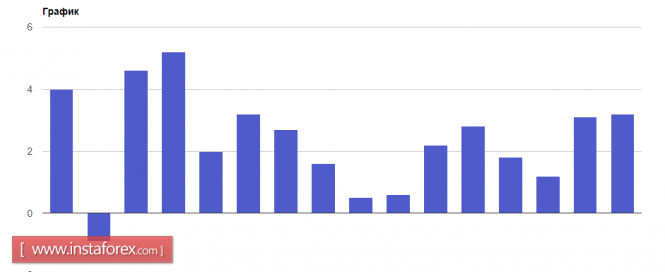 The main reason for the decline in the indicator was consumer spending, which dropped further during the reporting period than previously thought. Growth was noted in company investments and exports. As for the technical picture of the EURUSD pair, an unsuccessful attempt to get beyond the resistance level of 1.1885 led to the expected downward correction in the trading instrument, which will likely be limited to support levels around 1.1830 and 1.1805. The British pound rose after data on reduced borrowing of the UK public sector. According to the report, in November of this year, the net borrowing of the UK public sector decreased and amounted to 8.7 billion pounds compared to the same period of last year. As noted in the report, borrowing declined due to increased tax revenue. As for the technical picture of the GBPUSD pair, it is likely that the pressure on the pound will continue and that will lead to a decline in the trading instrument towards the lower border of the channel to the area of 1.3330 and 1.3300, from which it was possible twice to see the return to the market of large buyers of the British pound. Analysis are provided byInstaForex.
|
|
|
|
Post by instaforexgertrude on Dec 27, 2017 1:37:08 GMT -5
Inflation continues to grow in JapanWeekends and holidays are always accompanied by a low volume of trades against the background of lack of important fundamental statistics. Most likely, serious and purposeful movements will not be formed in the pairs EUR/USD and GBP/USD before the end of this year. Some leading experts expect that the growth of the US economy next year will significantly accelerate due to the approved program of tax cuts, and also due to an increase in government spending. Do not forget that at the end of last week, US President Donald Trump signed a new tax bill with a total cost of $ 1.5 trillion, which the budget will not be counted on. According to economists of Goldman Sachs, the measures taken by the White House administration will lead to a larger GDP growth in 2018. According to the data, the US GDP in 2018 will grow by 2.6%, and 1.7% in 2019. These data were revised upwards by 0.3% and 0.2%. Economists of J.P. Morgan also expects more significant growth in consumer spending, which will stimulate the economy of the country, adding to the previous forecast of 0.2%. In J.P. Morgan forecasts, the US GDP growth of 2.1% next year. As for the technical picture of the EUR/USD pair, it did not change significantly compared to the forecast at the end of last week. Only a confident exit to the resistance level 1.1880 will lead to the formation of a new upward wave, with an update of the monthly highs of 1.1900 and 1.1935. The data on consumer price growth in Japan did not lead to significant changes in the USD/JPY pair, even despite the increase in the index which is a positive sign for the Bank of Japan. According to the report of the Ministry of Internal Affairs and Communications of Japan, the base consumer price index in November rose by 0.9% compared to the same period of the previous year after an increase of 0.8% in October. While economists expected the index to grow by 0.8%. The general consumer price index rose by 0.6% in November after rising to 0.2% in October this year. Economists predicted an increase of 0.5%. 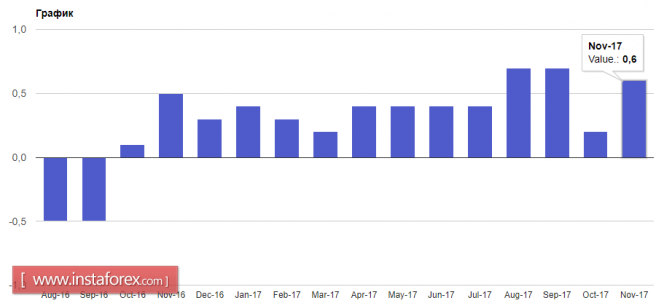 Despite the lack of strong impetus, prices continue to grow for 11 consecutive months, which makes the Bank of Japan feel more relaxed. The index, excluding the prices of fresh food and energy, rose by 0.3% compared with the same period in 2016 after an increase of 0.2% in October. Today, the unemployment rate in Japan in November 2017 fell to 2.7% from 2.8% in October, as the number of jobs increased. As indicated in the report, there were 100 applicants in November who had 156 jobs compared to 155 in October. * The presented market analysis is informative and does not constitute a guide to the transaction. *The market analysis posted here is meant to increase your awareness, but not to give instructions to make a trade. Analysis are provided byInstaForex.
|
|
|
|
Post by instaforexgertrude on Dec 28, 2017 0:11:23 GMT -5
Prepare to sell below major resistanceThe price is approaching major resistance at 113.76 (76.4% Fibonacci retracement, Fibonacci extension, horizontal overlap resistance) and we expect a strong reaction off this level to push the price down to at least 112.13 support (Fibonacci retracement, multiple horizontal swing low support). Stochastic (55,3,1) is dropping nicely from our 97% resistance with good downside potential. Sell below 113.76. Stop loss is at 114.54. Take profit is at 112.13. 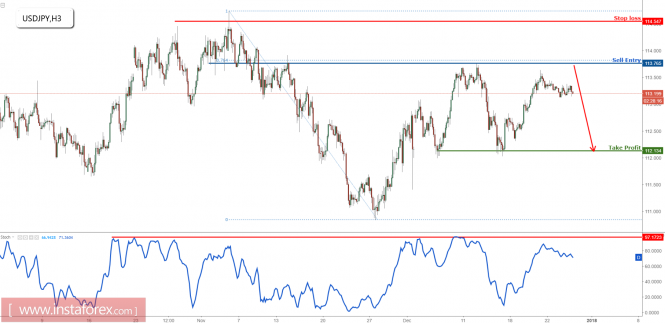 *The market analysis posted here is meant to increase your awareness, but not to give instructions to make a trade. Analysis are provided byInstaForex.
|
|
|
|
Post by instaforexgertrude on Jan 3, 2018 0:35:02 GMT -5
Wave analysis of the USD / JPY currency pair. Weekly review Analysis of wave counting: At the end of last week, the pair USD / JPY still began to decline, losing about 90 pp and was able to work out the mark of 112.50 in the middle of the Friday session. Thus, it seems that the currency pair has attempted to confirm the transition to the stage of formation taking a rather complex form of the waves c, b, a, (C). If this is the case, then in the process of the development of the wave structure of this wave c, b, a, (C), the currency pair can continue the already identified downward movement in the direction of the levels of the 111th or even 110th figure. Targets for the downward wave option: 111.01 - 50.0% of Fibonacci 110.14 - 61.8% of Fibonacci Targets for the upward wave option: 115.43 - 61.8% of Fibonacci 116.32 - 76.4% of Fibonacci General conclusions and trading recommendations: The pair USD / JPY continues to build the upward wave (C). Thus, the increase in quotations may continue within the wave c, a, (C) with targets located near the estimated levels of 115.43 and 116.32, which corresponds to 61.8% and 76.4% of Fibonacci (these goals will be reviewed). The assumed wave b, a, (C) can resume its construction, complicating its internal wave structure. *The market analysis posted here is meant to increase your awareness, but not to give instructions to make a trade. Analysis are provided byInstaForex.
|
|
|
|
Post by instaforexgertrude on Jan 4, 2018 1:43:02 GMT -5
Traders are waiting for the Fed's MinutesData on the good condition of the German labor market slightly supported the European currency, which began to gradually lose its positions paired with the US dollar after the pre-New Year rally that was observed in the entirety of the previous week. According to the report of the Federal Ministry of Labor of Germany, the number of applications for unemployment benefits in Germany in December 2017 decreased by 29,000, while economists had expected a decrease in the number of applications by only 10,000. Data for November were revised. The final report indicates a decrease in the number of applications for 20,000, not 18,000, which was previously announced. The unemployment rate in December was 5.5%. 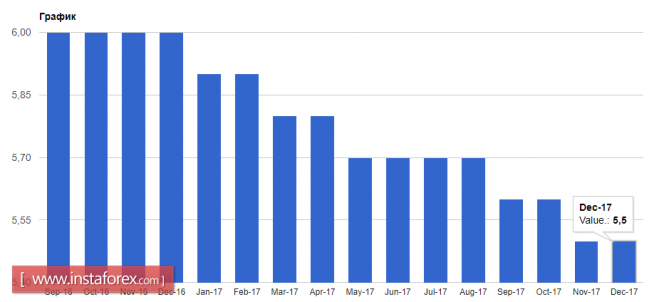 While the market is just beginning to "swing" after the New Year holidays, all investors' attention today will be directed to the publication of the Fed's minutes from the meeting that took place last year on December 12 and 13. It should be noted that it decided to raise federal funds rates by a quarter of a percentage point to the range of 1.25% -1.50%. In the minutes, it will be more significant to expect further interest rate increases early in 2018. Analysts predict at least three of such increases. The timing of the next rate increase will also be important. If it is the 1st quarter of this year, it is possible that the demand for the US dollar may return, as there are no plans to change the policy of the European Central Bank until spring. Retail sales, according to The Retail Economist and Goldman Sachs, fell after the Christmas week. According to the report, for the week from December 24 to December 30, the sales index in US retailers fell by 2.3% compared to last week. In comparison with the same period in 2016, the sales index in US retail chains grew by 3.9%. As for the technical picture, the attempt of the bulls in the morning to reach on an important level of resistance in the area of 1.2070 was unsuccessful. As a result, the scenario began to develop in line with a bearish forecast. Now you can expect the support in the area of 1.2000 and 1.1955. Talk about the resumption of the upward trend in the euro will be possible after consolidation above 1.2055. The British pound, though not immediately, but began to decline gradually against the US dollar after a weak report in the construction sector of the UK. According to the statistics agency,, the index of supply managers for the construction sector of the UK in December 2018 fell to the level of 52.2 points from 53.1 points in November. It should be noted that the value above 50 points indicates the retention of activity, despite the decline in the index. *The market analysis posted here is meant to increase your awareness, but not to give instructions to make a trade. Analysis are provided byInstaForex.
|
|
|
|
Post by instaforexgertrude on Jan 5, 2018 1:21:20 GMT -5
Euro and pound win back their positions against the US dollarGood data for the euro area and the UK in the first half of the day led to a slight strengthening of the European currency and the British pound after yesterday's decline, which was noticed after the publication of the Fed's protocols. According to the IHS Markit report, the composite PMI of the euro zone's supply managers rose to 58.1 points in December from 58.0 points. This once again confirms the fact that economic activity in the eurozone at the end of 2017 remained at a fairly strong level. This allows you to count on excellent indicators for GDP growth. Also, it is most likely that in early 2018, the current growth rate of activity will continue due to the flow of new orders. As for the technical picture of the EURUSD pair in the short term, the exit beyond the level of 1.2035, which I recommended to pay attention to in the morning review, led to the resumption of purchases of the European currency. The next target is a break above the monthly highs, which will lead to the renewal of new resistance levels of 1.2125 and 1.2170. The British pound strengthened its position against the US dollar against the backdrop of good data on the service sector, which accounts for a significant portion of the UK GDP. According to IHS Markit's report, PMI's supply managers index for the UK services sector increased to 54.2 points in December 2017 against 53.8 points in November. Economists had expected the index in December to be at 54.0 points. The IHS Markit report noted that business growth accelerated at once in all regions of the UK. 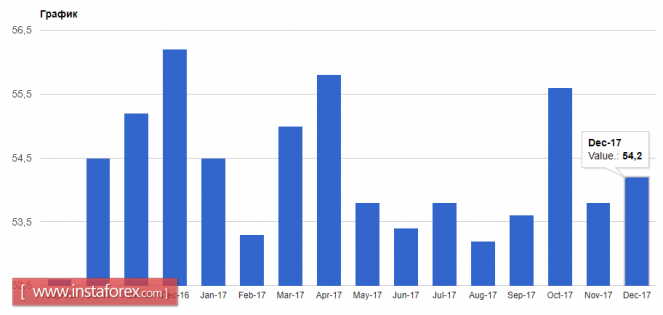 Today, the number of approved mortgage loans in the UK was published for November which increased compared to October. Despite this, growth is gradually slowing down, indicating a decrease in activity in the housing market. So, according to the Bank of England, the number of approved mortgage loans in the UK in November 2017 was at 65 140 against 64 890 in October. Meanwhile, the average for the last 6 months was at 66 562, indicating a likely decrease in activity. According to the Nationwide Building Society, housing prices in the UK in December last year rose by 2.6% compared with the same period in 2016. Unsecured consumer lending in the UK also began to gradually slow down. According to the same Bank of England, unsecured consumer lending in November 2017 grew by only 1.4 billion pounds, while economists expected a 1.6 billion pounds increase in lending. Compared to November 2016, lending grew by 9.1%. Analysis are provided byInstaForex.
|
|
|
|
Post by instaforexgertrude on Jan 8, 2018 0:35:23 GMT -5
NZD/USD approaching major resistance, prepare to sell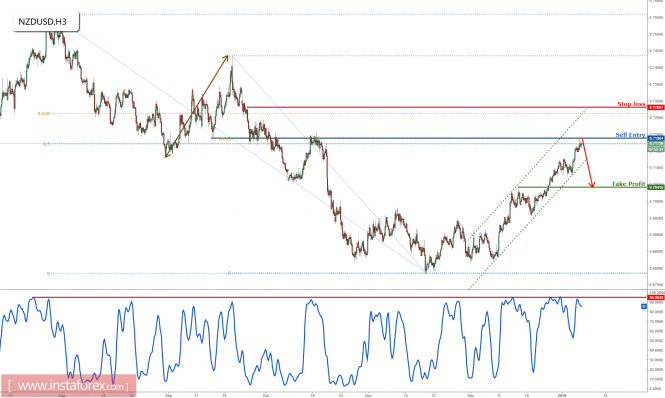 The price is testing major resistance at 0.7188 (Fibonacci retracement, horizontal overlap resistance, bearish divergence) and a strong reaction could occur at this level to push the price down to at least 0.7041 support (Fibonacci retracement, horizontal pullback support). However, we are also in a bullish ascending channel and only a break of this channel would confirm further downside move. Stochastic (34,5,3) is seeing major resistance at 94% and also displays bearish divergence vs price signaling that a reversal is impending. Sell below 0.7188. Stop loss is at 0.7280. Take profit is at 0.7041. Analysis are provided byInstaForex.
|
|
|
|
Post by instaforexgertrude on Jan 9, 2018 1:17:09 GMT -5
Elliott wave analysis of EUR/NZD for January 9, 2018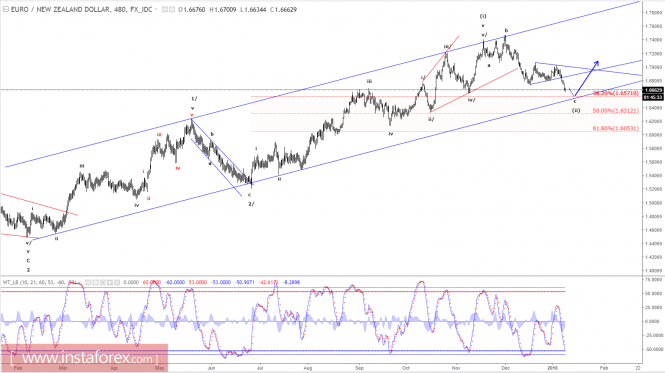 Wave summary: EUR/NZD has declined nice and is now close to the first support near 1.6571. This support is expected to protect the downside for at least a corrective rally closer to 1.6800 and maybe even turn prices higher trough important resistance at 1.7025 for the next impulsive rally towards 1.7777. R3: 1,6890 R2: 1.6800 R1: 1.6701 Pivot: 1.6630 S1: 1.6571 S2: 1.6447 S3: 1.6298 Trading recommendation: We are short EUR from 1.6795. We will book half profit here at 1.6675 for a nice profit of 120 pips and we will move our stop lower from 1.7085 to 1.6835 on the rest of the position. Analysis are provided byInstaForex.
|
|


















